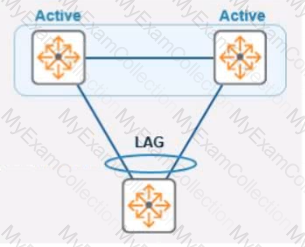You need to ensure that voice traffic sent through an ArubaOS-CX switch arrives with minimal latency. What is the best scheduling technology to use for this task?
What information is required when using the ClearPass self-service registration page to generate a Multiple Pre-Shared Key (MPSK) for headless devices?
Based on the "snow ip route" output on an AruDaCX 8400. what type of route is "10.1 20 0/24, vrf default via 10.1.12.2. [1/0]"?
When does the 802.1x authentication process begin when connecting to a secured enterprise mode WLAN?
You are in a meeting with a customer where you are asked to explain how the network redundancy feature VRRP works. What is the correct statement for this feature?
You are in a meeting with a customer where you are asked to explain the network redundancy feature Multiple Spanning Tree (MSTP). What is the correct statement for this feature?
Refer to the exhibit.

In the given topology, a pair of Aruba CX 8325 switches are in a VSX stack using the active gateway What is the nature and behavior of the Virtual IP for the VSX pair if clients are connected to the access switch using VSX as the default gateway?
A client connects to an Aruba AP in tunnel mode and is assigned to a VLAN based on the client's MAC address.
Which client VLAN assignment was configured?
The customer has a requirement to create authorization policies for their users with Windows 10 clients, with a requirement Tor authorizing both device and user credentials within one Radius session.
What would be the correct solution for the requirement?
A network technician is using Aruba Central to troubleshoot network issues Which dashboard can be used to view and acknowledge issues when beginning the troubleshooting process?
Match the Open Systems Interconnection (OSI) layer with its comparable member of the TCP/IP stack. (Options may be used more than once.)
Which statement is correct when comparing 5 GHz and 6 GHz channels with identical channel widths?
When using the OSPF dynamic routing protocol on an Aruba CX switch, what must match on the neighboring devices to exchange routes?
You need to troubleshoot an Aruba CX 6300F switch that fails to boot correctly. Select the option that allows you to access the switch and see the boot options available for OS images and ServiceOS.
You are working with a pair of 6300M switches in a VSF stack. The switch has 48 SmartRate 5G ports, 2 SFP28 ports, and 2 SFP56 ports. Both SFP56 ports are used for stacking.
You need to provide an LACP connection to another identical stack with the maximum available bandwidth possible. What should you configure?
Match the phase of message processing with the Open Systems interconnection (OSl) layer.

You have physical access to an Aruba CX-Switch with unknown/lost credentials. What are the possible steps to rebuild the credentials? (Select two.)








